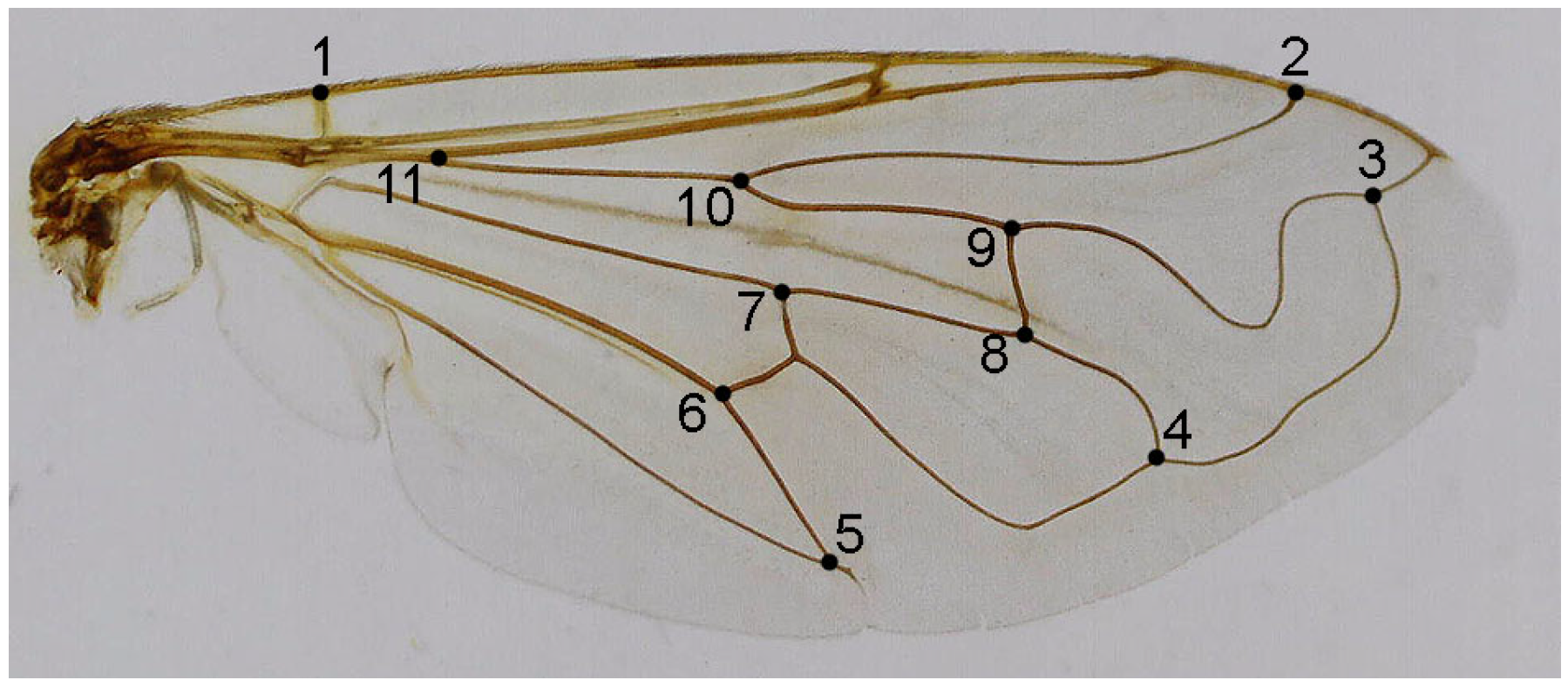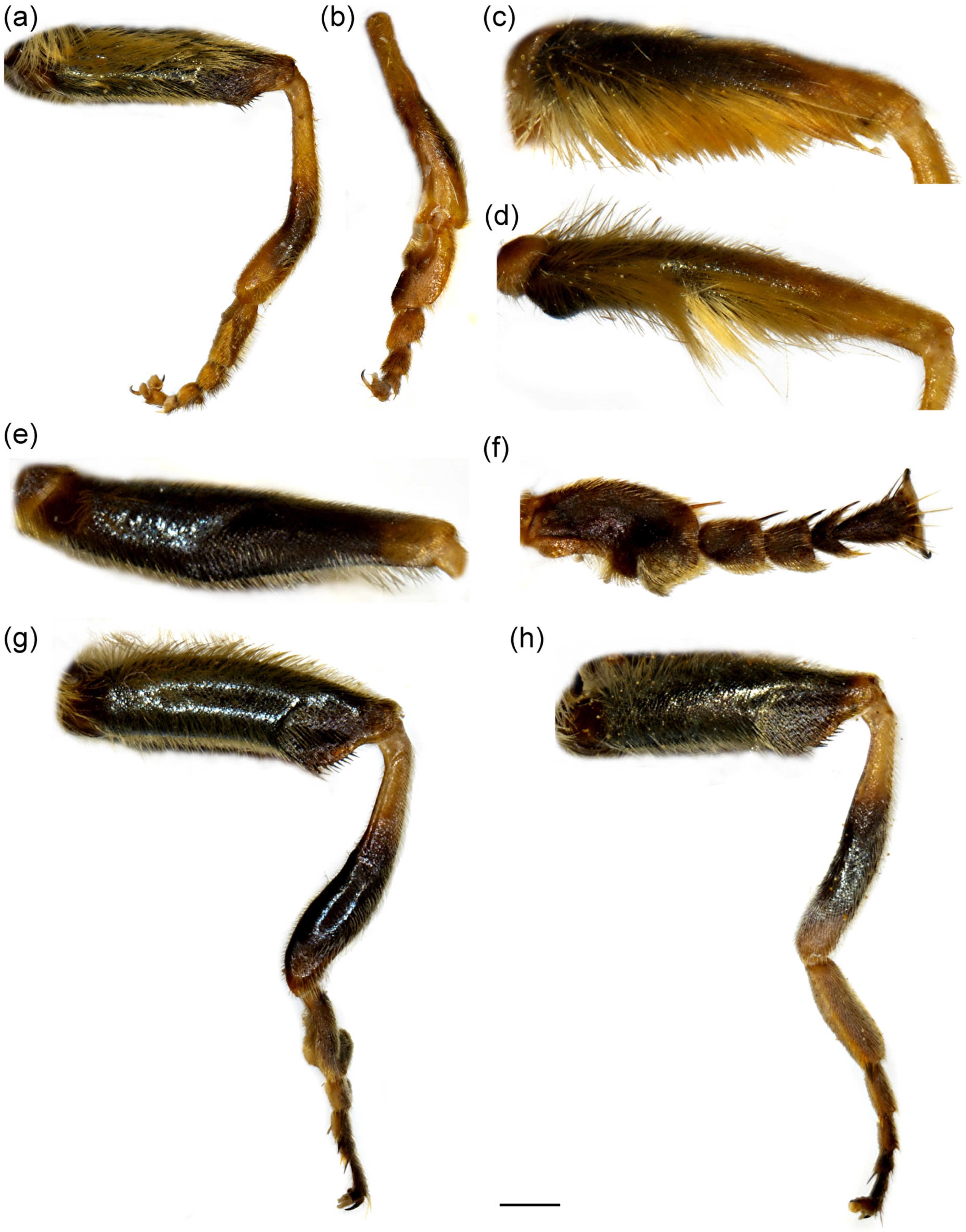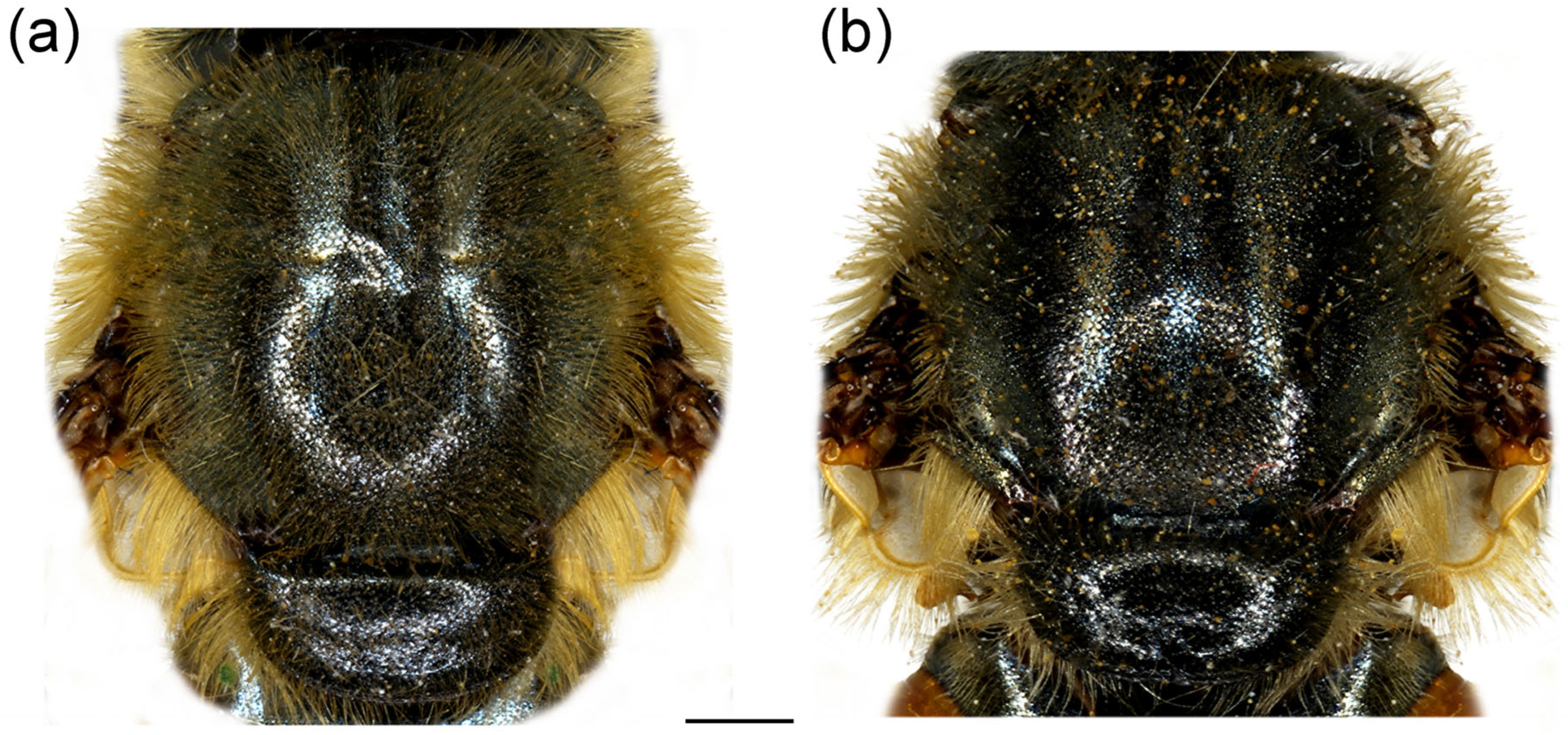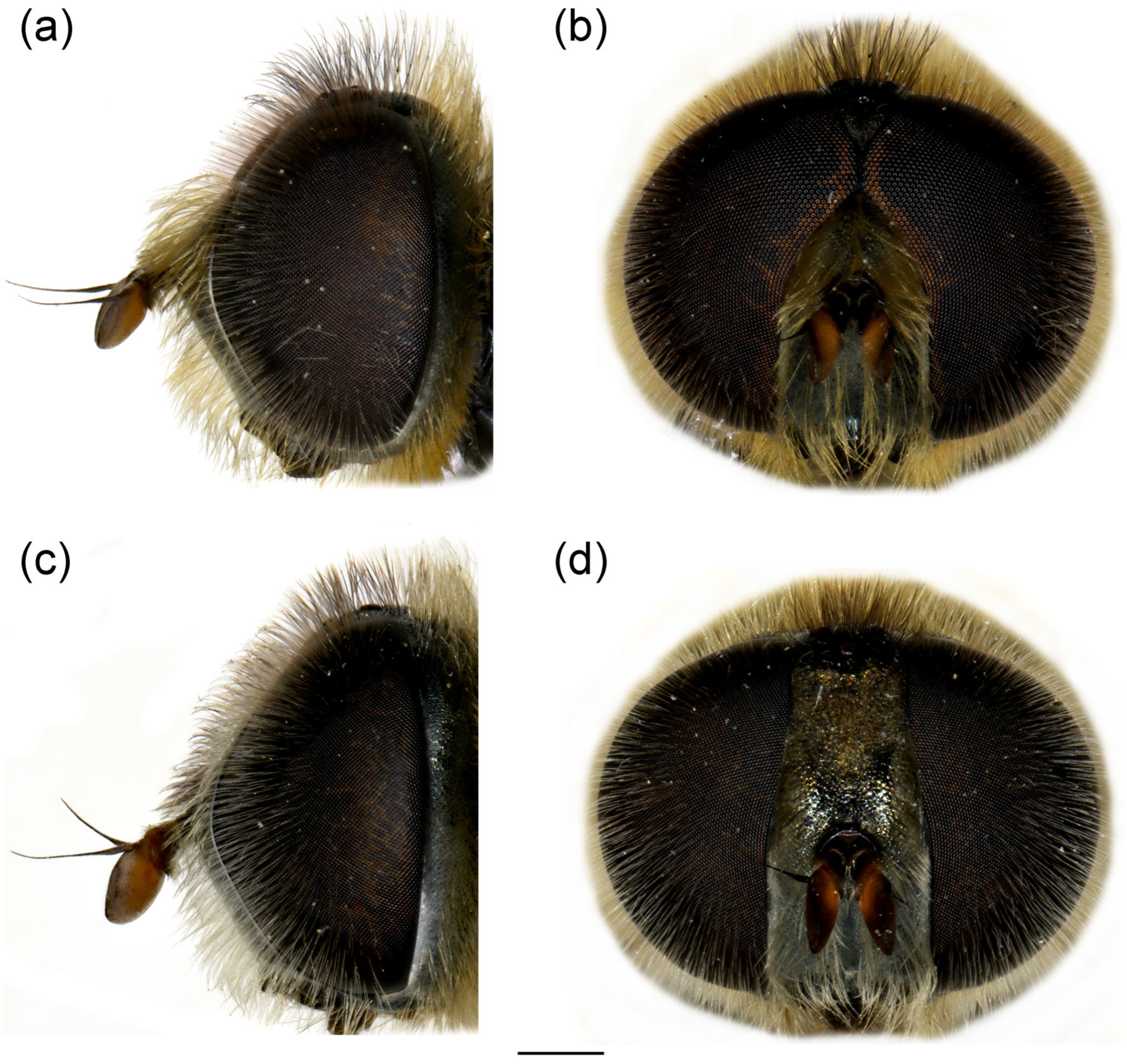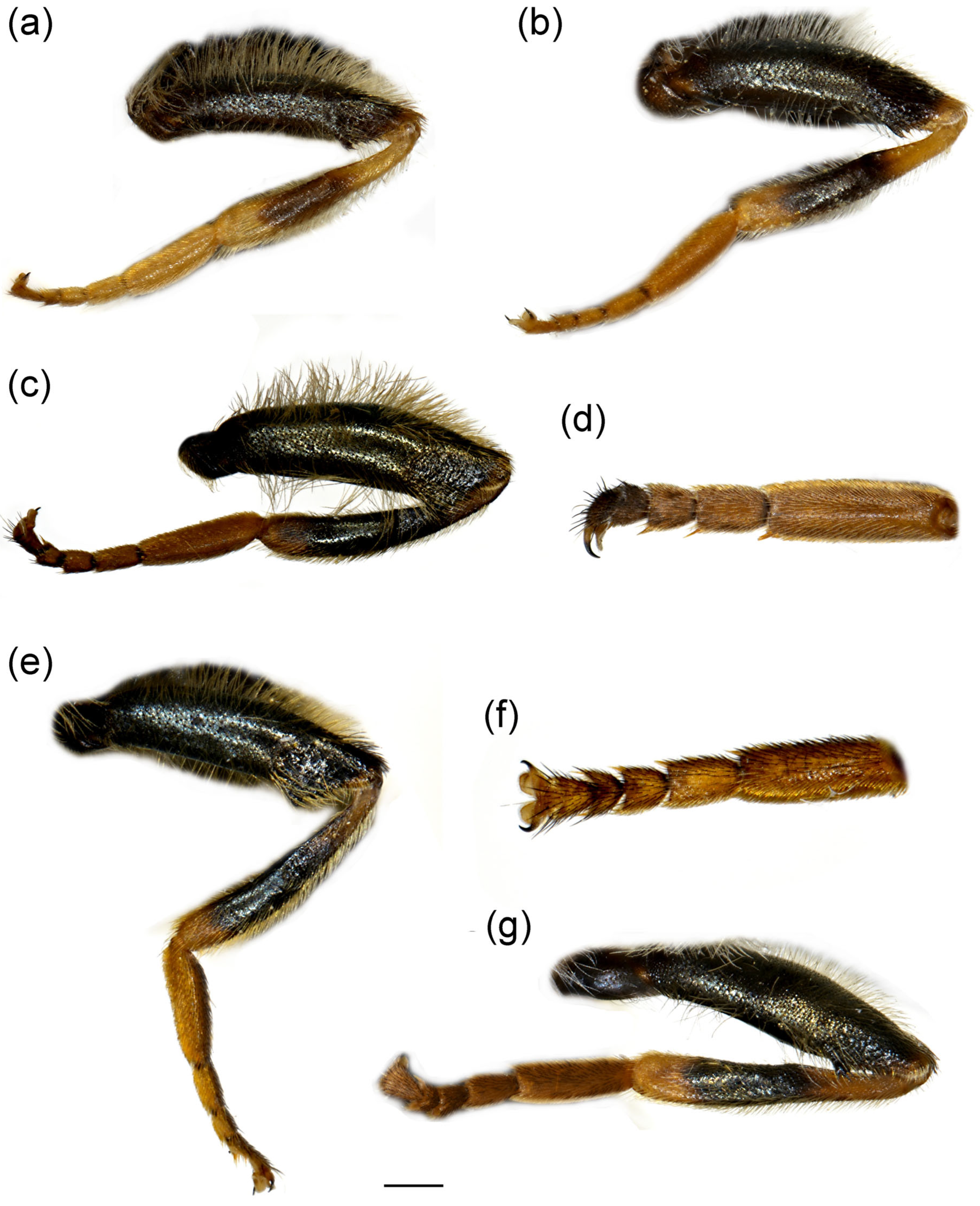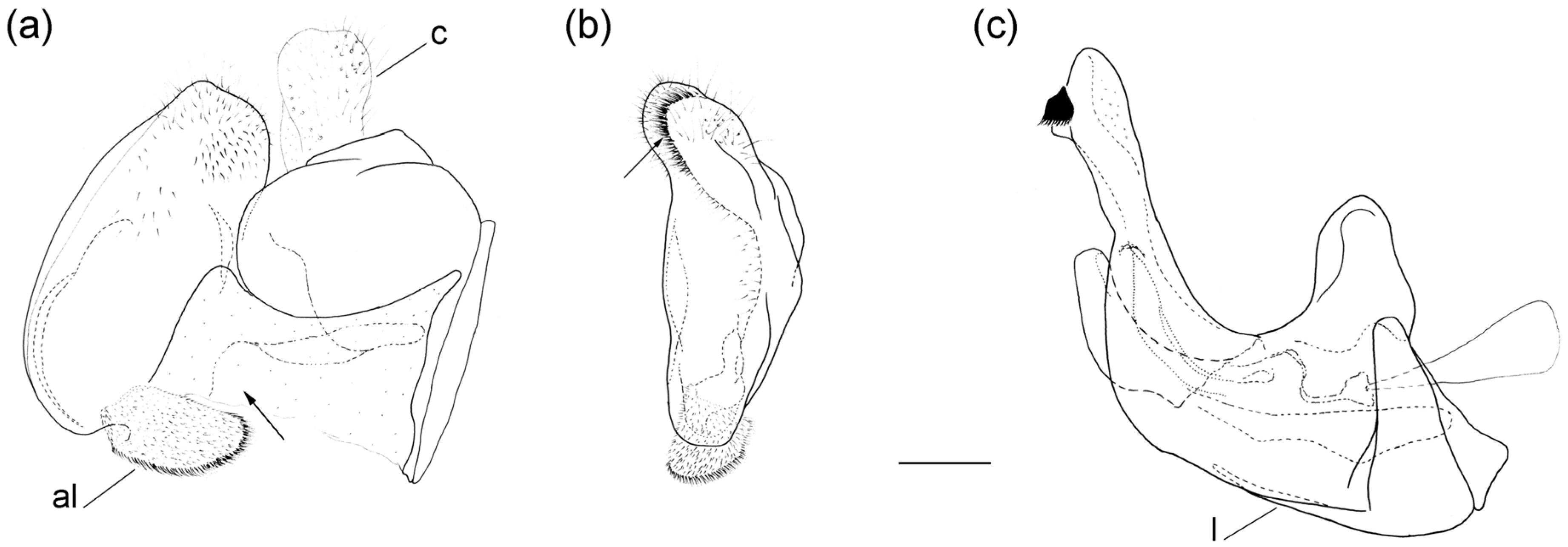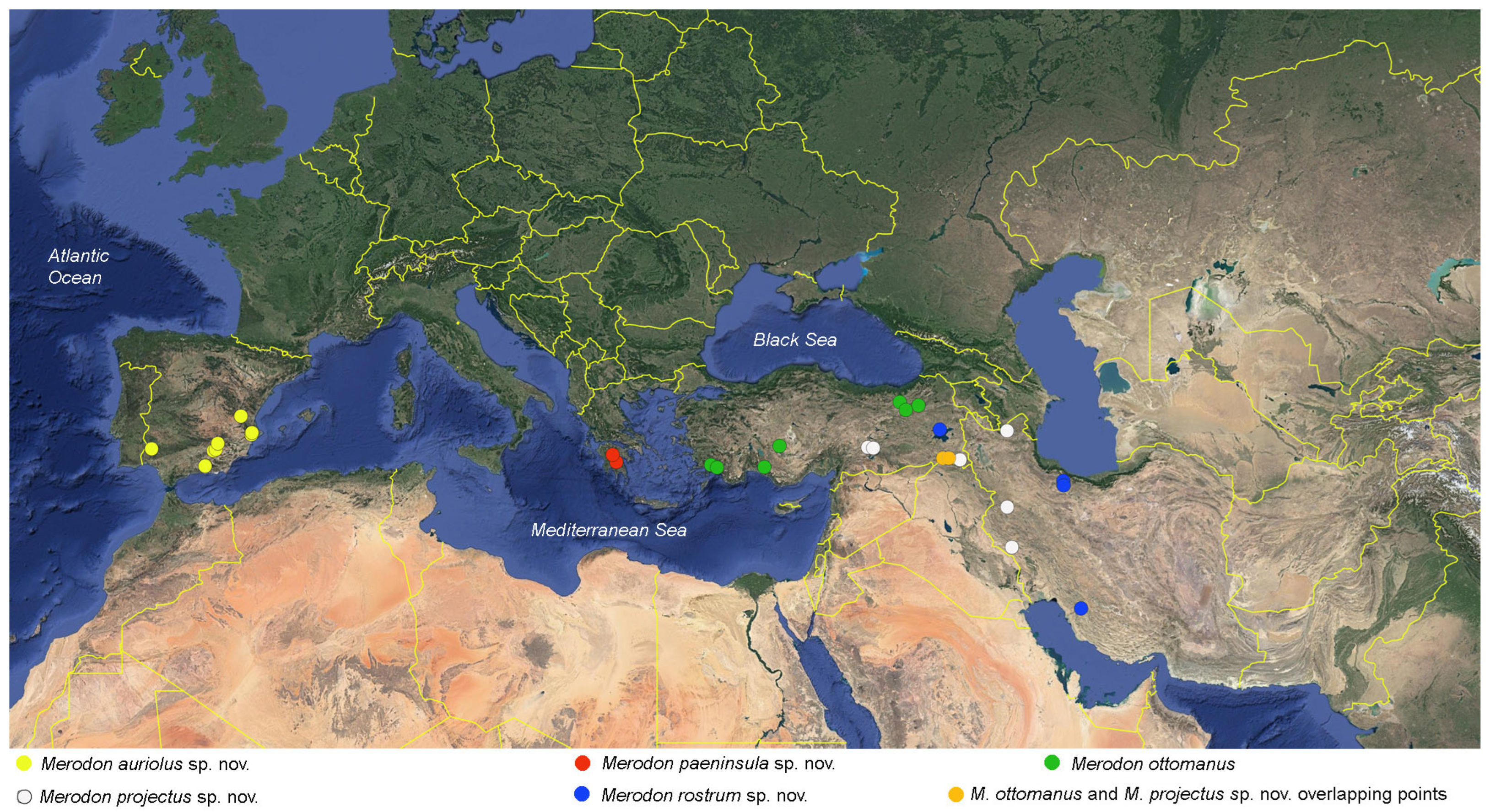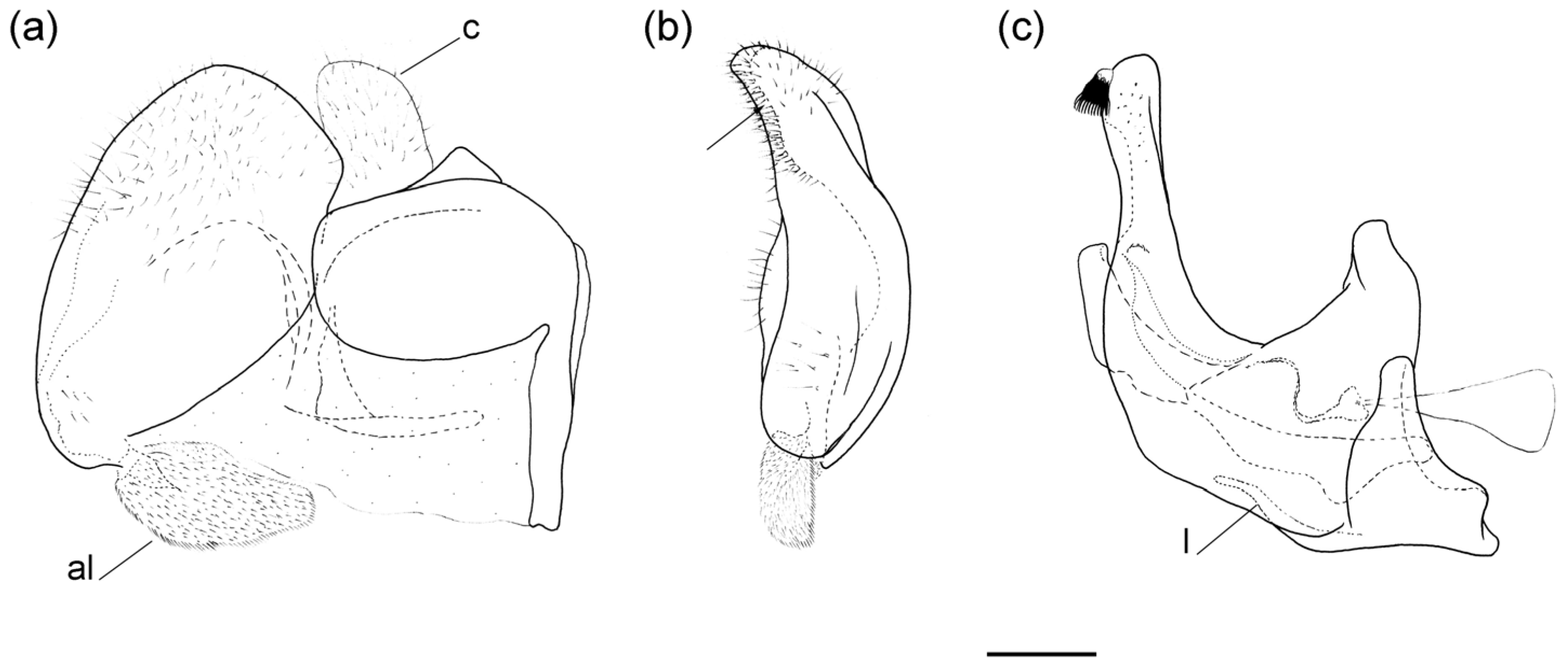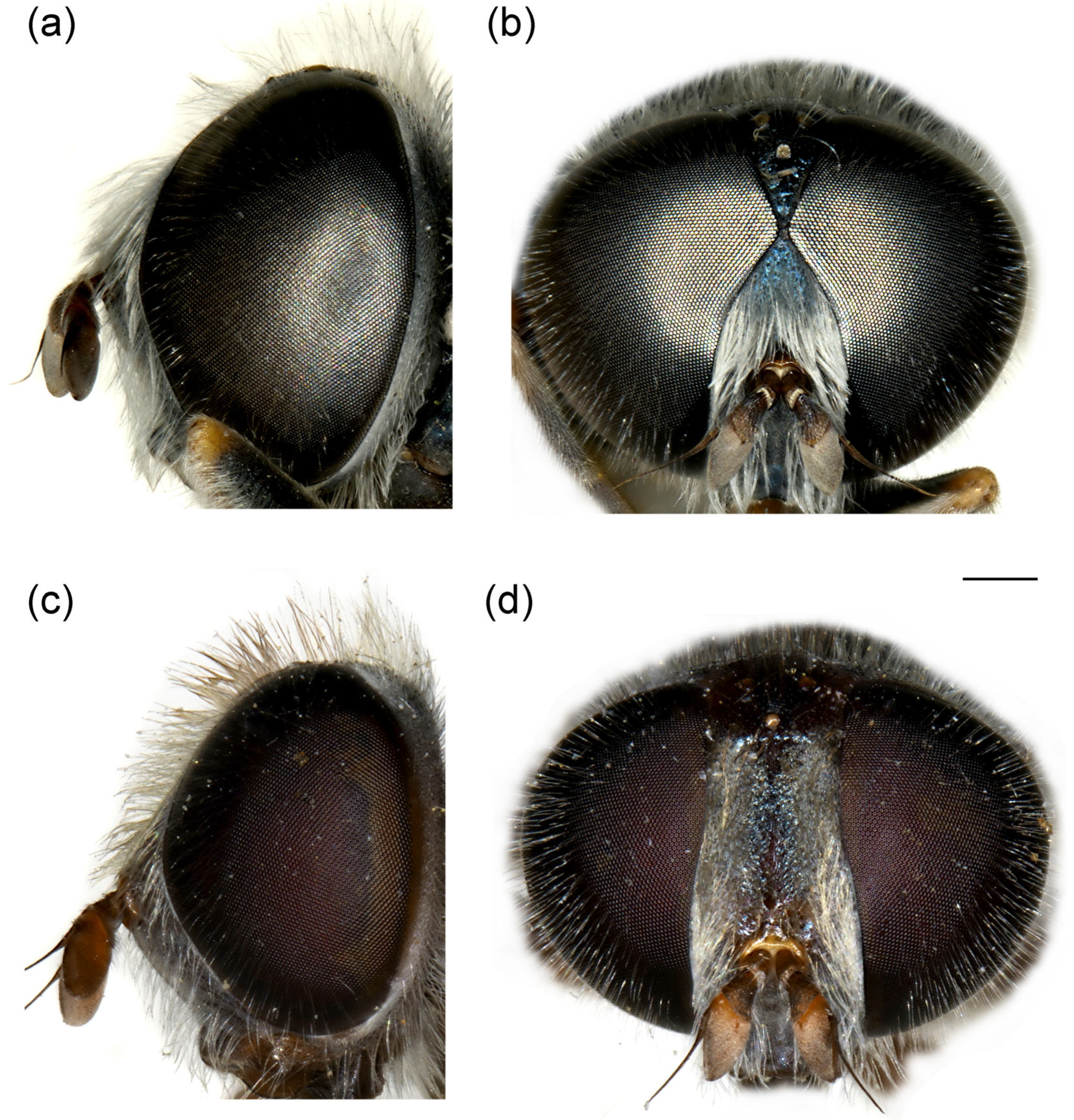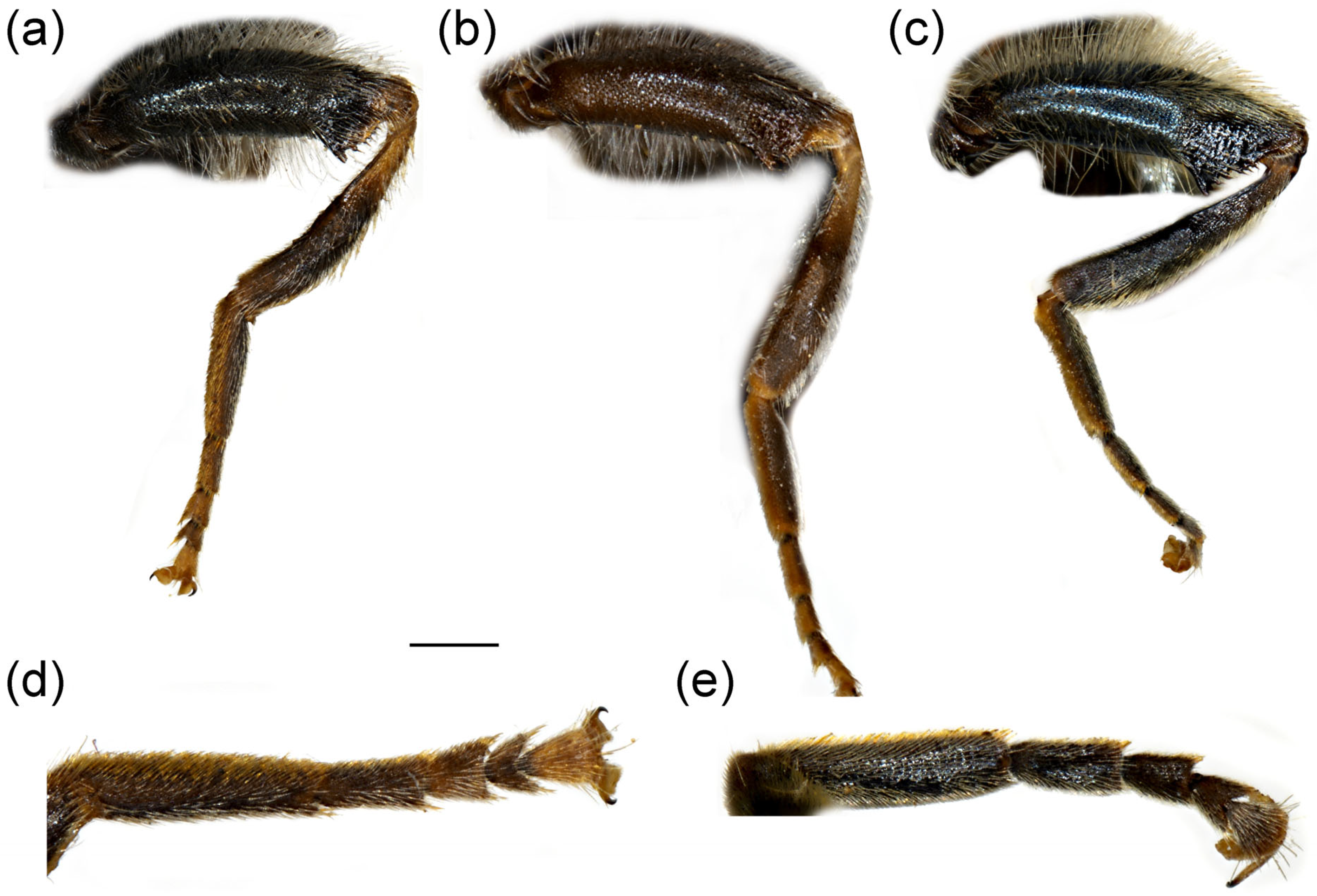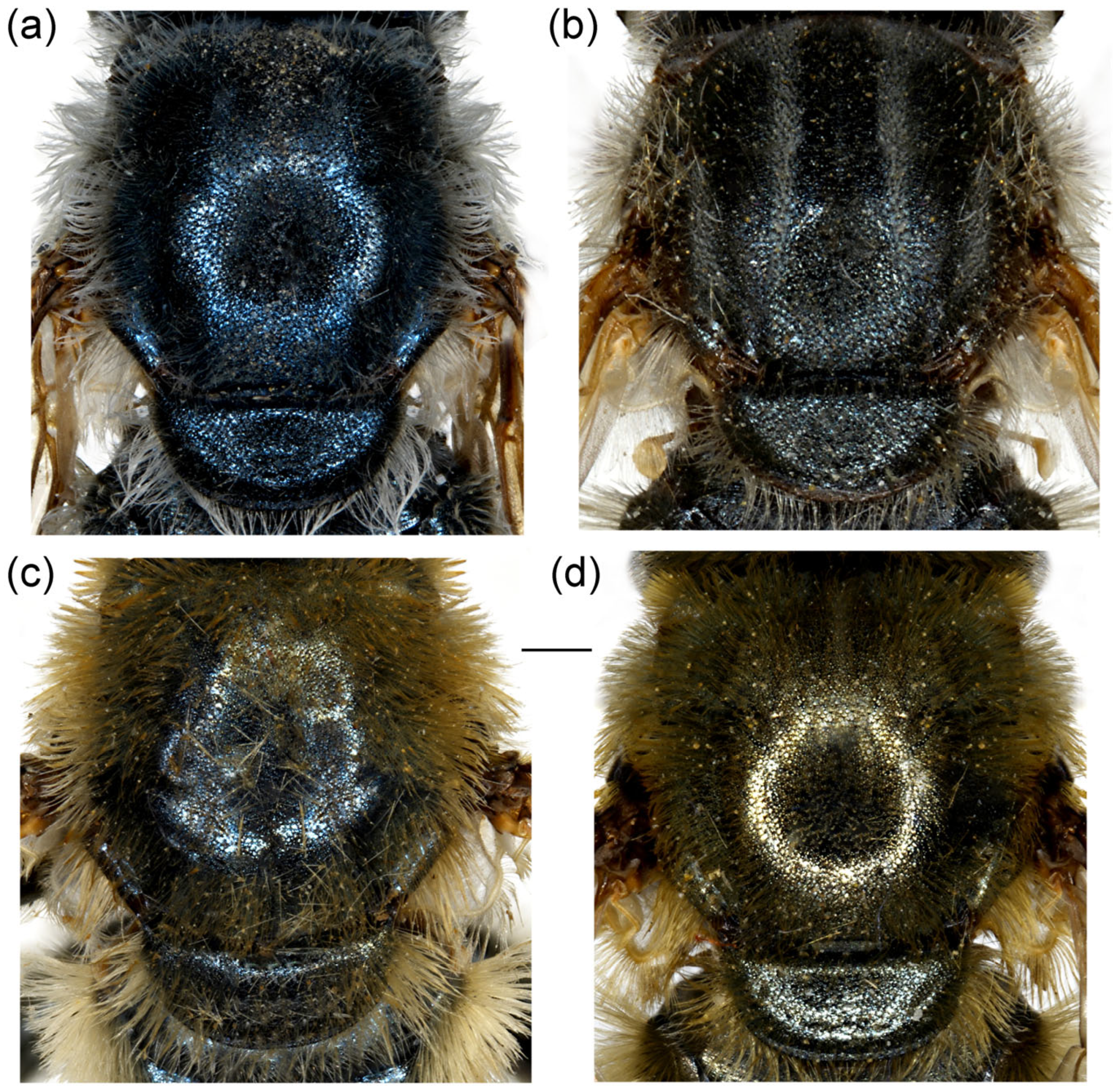3.1.2. Merodon caudatus Group
Diagnosis. Species with a unique metaleg morphology among the species of the
avidus-nigritarsis lineage: metatibia twisted in the apical half (as in
Figure 3a), metabasotarsomere strongly modified in males (as in
Figure 3b), less in females (as in
Figure 3h); tergum 2 with a pair of reddish yellow lateral, triangular maculae (as in
Figure 4a). Species of this group are restricted to Turkey, Israel, Syria, and Palestine (
Figure 5).
Figure 3.
Parts of legs. (a) Merodon caudatus, metaleg of male; (b) M. caudatus, metatibia and metatarsus of male; (c) M. caudatus, profemur of male; (d) M. caudatus, mesofemur of male; (e) M. crispotarsus sp. nov., mesofemur of male; (f) M. crispotarsus sp. nov., basitarsus of male; (g) M. crispotarsus sp. nov., metaleg of male; (h) M. crispotarsus sp. nov., metaleg of female. (a–e,g,h) lateral view; (f) dorsal view. Scale bar (a,g,h) 1 mm; (b,f) 0.5 mm; (c–e) 0.8 mm.
Figure 3.
Parts of legs. (a) Merodon caudatus, metaleg of male; (b) M. caudatus, metatibia and metatarsus of male; (c) M. caudatus, profemur of male; (d) M. caudatus, mesofemur of male; (e) M. crispotarsus sp. nov., mesofemur of male; (f) M. crispotarsus sp. nov., basitarsus of male; (g) M. crispotarsus sp. nov., metaleg of male; (h) M. crispotarsus sp. nov., metaleg of female. (a–e,g,h) lateral view; (f) dorsal view. Scale bar (a,g,h) 1 mm; (b,f) 0.5 mm; (c–e) 0.8 mm.
Figure 4.
Dorsal view of abdomen. (a) Merodon caudatus, male; (b) M. crispotarsus sp. nov., male; (c) M. crispotarsus sp. nov., female. Scale bar: 1 mm.
Figure 4.
Dorsal view of abdomen. (a) Merodon caudatus, male; (b) M. crispotarsus sp. nov., male; (c) M. crispotarsus sp. nov., female. Scale bar: 1 mm.
Figure 5.
Distribution map of the Merodon caudatus species group.
Figure 5.
Distribution map of the Merodon caudatus species group.
Merodon caudatus Sack, 1913
Diagnosis. Pro- and mesotrochanters yellowish red; metatibia curved (swollen) in apical third, enlarged at tip (
Figure 3a); all tarsi yellow, covered dorsally with erect pilosity (
Figure 3a); male pro- and mesofemora (
Figure 3c,d) posteriorly, and metafemur anteriorly with dense, strong, yellow pilosity; mesofemur with basal bulge ventrally (
Figure 3d); all tarsomeres of metatarsus strongly modified (
Figure 3b); male genitalia: in
Figure 6a–c: hammer-like posterior surstylar lobe (
Figure 6a: marked with an arrow).
Material examined. Neotype: 1♂, 01.vi.1972, leg. M. Doğanlar, [‘Type of M. claudius; MUS; 2♂♂/? aureotibia/Hurkm.’], FSUNS.
Note. The holotype from ‘Asia Minor’ (Turkey) was considered lost by Hurkmans [
44], and it was not located in the frame of the present study. Thus, we here designate a neotype based on material from the type locality (Turkey).
Additional material: TURKEY: 1♂, 01.vi.1972, leg. M. Doğanlar, [‘Type of M. claudius; MUS’], FSUNS (FSUNS ID 02226, ‘AM-05-58’); 1♀, 01.vi.1972, leg. M. Doğanlar, [‘MUS’], FSUNS (FSUNS ID 02227, ‘AM-05-227’).
Merodon crispotarsus Vujić, Likov et Radenković sp. nov.
urn:lsid:zoobank.org:act:2FACA83F-FAD6-4147-AD70-9D5DF7039393
Material examined. Holotype: 1♂, ISRAEL, Gilboa, 01.iv.1998, leg. A. Freidberg, FSUNS (FSUNS ID 04901).
Paratypes: ISRAEL: 1♂, Mount Carmel, Bat Shlomo, 32.5967° N 35.0019° E, 22.iii.1981, leg. N.B.M. Brantjes, [det. as Merodon caudatus Sack, 1913 by A. Vujić (2008) and by J.A.W. Lucas], NBCN (FSUNS ID 02224, ‘AM-05-23’); 4♂♂, 1♀, Tivon, 03.iv.1973, leg. F. Nachbar, TAU; 4♂♂, 1♀, Tivon, 02.iv.1975, leg. F. Kaplan, TAU; 1♀, Tivon, 02.iv.1975, leg. F. Kaplan, [det. as Merodon caudatus Sack, 1913 by W. Hurkmans (1994) and by A. Vujić], TAU (FSUNS ID 04958); 1♂, same data as for preceding, TAU (FSUNS ID 04916); 1♀, Mount Carmel [Har Karmel], M. Haifa, 32.7286° N 35.0467° E, 16.iv.1980, leg. I.A.W. Lucas, [det. as Merodon caudatus Sack, 1913 by W. Hurkmans (1995) and by A. Vujić (2008)], NBCN (FSUNS ID 02225, ‘AM-05-24’); 1♂, Carmel, Haifa, 10.iv.1947, TAU; 1♂, Haifa, 26.iii.1977, leg. A. Freidberg, [det. as Merodon caudatus Sack, 1913 by W. Hurkmans (1994) and by A. Vujić], TAU (FSUNS ID 04963); 1♂, Haifa, 12.iv.1963, leg. Kugler, [“Kugler L. caudata”], TAU; 1♀, Gilboa, 17.iii.1978, leg. Kugler, TAU; 6♂♂, 3♀♀, Gilboa, 01.iv.1998, leg. A. Freidberg, TAU; 1♂, Gilboa, 01.iv.1998; leg. A. Freidberg, ‘M. caudatus’, TAU (FSUNS ID 04888); 1♀, same data as for preceding, FSUNS (FSUNS ID 04889); 1♀, Gilboa, 01.iv.1998, leg. A. Freidberg, FSUNS (FSUNS ID 04967); 1♀, Gilboa, 01.iv.1998, leg. A. Freidberg, [det. as Merodon caudatus Sack, 1913 by A. Vujić], TAU (FSUNS ID 04964); 1♀, Jerusalem, KiriethSemhuel, 05.iv.1936, TAU; 1♂, Jerusalim, Wadi RuazBethakerem, 24.iii.1951, leg. O. Theodor, TAU; 1♂, same data as for preceding, 20.iv.1953, TAU; 1♀, Bat Jamal, 23.iii.1968, TAU; 1♂, Ga’aton, 33.0062° N 35.2145° E, 21.iv.1973, leg. M. Kaplan, TAU; 1♀, same data as for preceding, [“M. Kaplan M. caudatus”], TAU; 1♂, W. Faria, 01.iii.1973, leg. A. Freidberg, TAU; 2♂♂, same data as for preceding, leg. M. Kaplan, TAU; 1♂, same data as for preceding, [“M. Kaplan M. caudatus”], TAU; 1♂, W. Ara, 23.iii.1974, leg. F. Kaplan, TAU; 2♀♀, same data as for preceding, leg. F. Nachbar, TAU; 1♂, Nahshonim, 20.iii.1974, leg. F. Kaplan, [“Sack, M. caudatus”], TAU; 2♂♂, 2♀♀, Gollani Jun., 23.iii.1974, leg. M. Kaplan, TAU; 1♂, same data as for preceding, 28.iii.1974, TAU; 1♂, Zova, 31.iii.1974, leg. M. Kaplan, TAU; 1♀, Ma’ale Hachamicha, 30.iii.1974, leg. F. Nachbar, TAU; 1♂, Beit Guvrin, 27.iii.1976, leg. A. Freidberg, TAU; 1♂, 1♀, Zecharia, 26.iii.1978, leg. A. Freidberg, TAU; 1♂, Yarbi, 21.ii.1978, leg. M. Kaplan, [“found fresh pupa few days later stigmae appeared”], TAU; 1♀, Har Sumaq (Carmel), 25.iii.1979, leg. Kugler, TAU; 1♂, Ma’agan Michael dunes, 28.iii.1984, [“C. O’Toole Aiincopvith B. museum visit 09/2010”], TAU; 1♂, Carmel, 25.iii.1984, leg. A. Hefetz, TAU; 1♀, Galin w., 23.iii.1986, leg. Sheny—dor E., TAU; 1♀, Zikron Ya’acov, 01.iv.1998, leg. A. Freidberg, TAU; 3♂♂, Zomet Haela, 02.iv.1999, leg. A. Freidberg, TAU; 1♀, Shoham, 18.iii.2005, leg. C. Grach, TAU; 1♀, Shoham, 23.iii.2007, leg. K. Levi, T. Hughes Games, TAU; 1♂, Shoham, 04.iv.2009, leg. G. Wizen, TAU; 1♂, Jerusalem, Beit HaKerem, 31.7833° N 35.2° E, 17.iii.1951, leg. O. Theodor, [det. as Lampetia caudata Sack by V. Doesburg, det. as Merodon caudatus Sack, 1913 by A. Vujić 2008], [‘Museum Leiden/Collectie Van Doesburg/rec. 1973’], NBCN (FSUNS ID 04087); 1♀, same data as for preceding, NBCN (FSUNS ID 04088); 1♂, Jerusalem, Beit HaKerem, 17.iii.1951, leg. O. Theodor, TAU; 1♂, 1♀, same data as for preceding, [det. as Lampetia caudata by Doesburg, det. as Merodon caudatus by Hurkmans Willem], TAU; 1♂, 1♀, Copula Beit HaKerem Jerusalem, 07.v.1949, leg. O. Theodor, TAU; 1♂, Chanita, 08.iv.1946, leg. Bylinski Salz, TAU.
STATE OF PALESTINE: 1♀, Yakir, 04.iv.1981, leg. A. Freidberg, FSUNS (FSUNS ID 04975); 2♀♀, same data as for preceding, TAU; 1♀, Benjamina, 16.iii., leg. Bylinski Salz, TAU; 1♂, Elon, 21.iii.1946, leg. Bylinski Salz, TAU; 1♂, Shuneh Bentaminah coastal plane, 08.iv.1953, leg. Theodor O., TAU; 1♂, 1♀, Shune coastal plane, 07.iv.1954, leg. Theodor O., TAU; 1♀, same data as for preceding, 08.iv.1954, TAU.
Additional material: ISRAEL: 1♂, Jerusalem, Beit HaKerem, 31.7833° N 35.2° E, 17.iii.1951, leg. O. Theodor, [det. as Lampetia caudata by P.H. van Doesburg, ‘P.H. van Doesburg collection rec. 1973’, det. as Merodon caudatus by A. Vujić], NBCN; 1♀, same data as for preceding, NBCN; 1♂, 1♀, Mount Carmel, Bat Shlomo, 32.5967° N, 35.0019° E, 22.iii.1981, NBCN; 1♂, same data as for preceding, [“Neotype of Merodon caudatus by Hurkmans 1988”, “J.A.W. Lucas collection”], NBCN.
SYRIA: 1♀, Orontes, 30 km SW Homs, 500 m, 15.iv.1992, leg. Warncke, ZFMK (FSUNS ID 25345, ZFMK-DIP-00069636).
Note. All available material of the Merodon caudatus group from museums was identified as Merodon caudatus. We discovered the existence of an additional species under this name, and this additional species resulted in having a different distribution than M. caudatus. The species from Turkey is the typical M. caudatus based on the type locality, whilst the species from Israel, Syria, and Palestine is described here as a new species, M. crispotarsus sp. nov.
Diagnosis. Mesofemur enlarged ventro-medially (
Figure 3e); metatibia twisted in the apical fourth (
Figure 3g); metabasotarsomere black at least dorsally; metatarsomeres with strong black setulae dorso-laterally (
Figure 3f); metabasotarsomere modified; other leg tarsomeres of the usual shape; in male tergum 5 modified, protruded with a pair of apical tufts of long yellow pile (
Figure 4b).
Description
Male
Head. Antenna black; basoflagellomere elongated, about 1.5× longer than wide (
Figure 7a); fossette large, dorso-lateral; arista thickened at basal third; face and frons black, with dense greyish pollinosity, face covered with dense pale yellow pilosity; pile on frons yellowish; oral margin shiny black, without pollinosity; lunula black to brown, bare; eye contiguity about 5–6 facets long; vertical triangle isosceles, shiny, black, covered with yellowish pilosity; ocellar triangle equilateral; occiput with yellowish pile, grey pollinose; eyes covered with long, whitish-grey pile.
Thorax. Scutum and scutellum black with brownish lustre, covered with long yellow to pale yellow pile; scutum with indistinct pollinose vittae (
Figure 8a); posterodorsal part of anterior anepisternum, posterior anepisternum (except anteroventral angle), anterior anepimeron, dorsomedial anepimeron, and posterodorsal and anteroventral parts of katepisternum with longer, dense whitish to yellow pile; wings mostly covered with microtrichia; wing veins brown to light brown; calypter and halter yellowish; legs black, except yellow apex of femora and basal third of tibiae; basal tarsomeres of proleg and mesoleg brown to yellow; basotarsomere of metaleg brown ventrally; apex of tibiae and tarsomeres of proleg and mesoleg with setulae, reddish on proleg and black on mesoleg; mesofemur enlarged ventro-medially (
Figure 3e); metatibia twisted in apical fourth (
Figure 3g); tarsomeres of metaleg with strong black setulae dorso-laterally (
Figure 3f); only basotarsomere of metaleg modified, other tarsomeres of the usual shape; femora and tibiae covered with yellow to whitish pile.
Figure 6.
Male genitalia of (a–c) Merodon caudatus; (d–f) M. crispotarsus sp. nov. (a,d) lateral view of epandrium; (b,e) ventral view of epandrium; (c,f) lateral view of hypandrium. Abbreviations: al—anterior surstyle lobe; c—cercus; l—lingula; pl—posterior surstyle lobe. The hammer-like posterior surstylar lobe is marked with an arrow. Scale bar 0.5 mm.
Figure 6.
Male genitalia of (a–c) Merodon caudatus; (d–f) M. crispotarsus sp. nov. (a,d) lateral view of epandrium; (b,e) ventral view of epandrium; (c,f) lateral view of hypandrium. Abbreviations: al—anterior surstyle lobe; c—cercus; l—lingula; pl—posterior surstyle lobe. The hammer-like posterior surstylar lobe is marked with an arrow. Scale bar 0.5 mm.
Figure 7.
Merodon crispotarsus sp. nov. (a) head of male, dorsal view; (b) head of male, frontal view; (c) head of female, dorsal view; (d) head of female, frontal view. Scale bar: 1 mm.
Figure 7.
Merodon crispotarsus sp. nov. (a) head of male, dorsal view; (b) head of male, frontal view; (c) head of female, dorsal view; (d) head of female, frontal view. Scale bar: 1 mm.
Figure 8.
Thorax of Merodon crispotarsus sp. nov., dorsal view. (a) male; (b) female. Scale bar: 1 mm.
Figure 8.
Thorax of Merodon crispotarsus sp. nov., dorsal view. (a) male; (b) female. Scale bar: 1 mm.
Abdomen. Elongated, about 1.3× longer than mesonotum; terga black, except for the reddish lateral, triangular maculae on tergum 2; terga 3–4 with a pair of grey pollinose fasciae (
Figure 4b); pilosity on the abdomen long, yellow to reddish, medially on terga shorter; pile very long on sternum 4 and tergum 4; tergum 5 modified, protruded with a pair of apical tufts of long yellow pile (
Figure 4b).
Male genitalia (
Figure 6d–f). Anterior surstylar lobe large, elongated, covered with short pile (
Figure 6d: al); posterior surstylar lobe rounded (
Figure 6d: pl) cercus oval (
Figure 6d: c); hypandrium sickle-shaped, without lateral projections; lingula present (
Figure 6f: l).
Female. Similar to male except for typical sexual dimorphism and for the following features: frons with broad pollinose vittae along eye margins, black pilose at the level of ocellar triangle (
Figure 7c,d); metatibia less twisted (
Figure 3h); basotarsomere of metaleg less modified (
Figure 3h).
Etymology. The specific epithet is formed from the Latin ‘crispum’, meaning curled/curly, plus ‘tarsus’, referring to the terminal part of a leg.
Distribution. Western parts of the Levant region, in Israel, Syria, and Palestine (
Figure 5).
Key to the species of M. caudatus group
- 1.
All tarsi yellow, covered dorsally with erect pilosity (
Figure 3a); in male pro- and mesofemora posteriorly, and metafemur anteriorly with dense, strong, yellow pilosity (
Figure 3a,c,d); mesofemur with basal bulge ventrally (
Figure 3d); all tarsomeres of metatarsus strongly modified (
Figure 3b); tergum 5 with the usual shape (
Figure 4a) ........................................................................................................
Merodon caudatus Sack, 1913- -
Tarsi partly black, without erect pilosity dorsally (
Figure 3g); in male, femora without dense, strong, yellow pilosity (
Figure 3e,g); only basotarsomere of metaleg strongly modified (
Figure 3f), other tarsomeres of the usual shape; tergum 5 modified, protruded, with a pair of apical tufts of long yellow pile (
Figure 4b) ....
Merodon crispotarsus sp. nov.
3.1.3. Merodon ottomanus Group
Diagnosis. Species characterised by the large, oval or rounded posterior surstylar lobe of the male genitalia (as in
Figure 9a: pl), and the very small anterior surstylar lobe (as in
Figure 9a: al). Includes medium-sized species (7–12 mm), with bronze reflections, characterised by the black shiny terga. Body covered with long yellowish to whitish pilosity; pile on frons and face dense and very long (as in
Figure 10c and
Figure 11a); basoflagellomere elongated, at least partly reddish-yellow ventrally; eye contiguity between 3 and 14 facets long; terga non pollinose or with narrow and weak silvery grey pollinose fasciae, more distinct in females; metafemur ventrally covered with long pile (as in
Figure 12c), metabasotarsomere more than 3× longer than wide (as in
Figure 12e).
This group has a fragmented range from the Iberian Peninsula through the Peloponnesus (Greece) and Turkey until Iran. Five species are included under the present concept of the group.
Figure 9.
Male genitalia of Merodon ottomanus. (a) lateral view of epandrium; (b) ventral view of epandrium; (c) lateral view of hypandrium. Abbreviations: al—anterior surstylar lobe; pl—posterior surstylar lobe. Scale bar: 0.2 mm.
Figure 9.
Male genitalia of Merodon ottomanus. (a) lateral view of epandrium; (b) ventral view of epandrium; (c) lateral view of hypandrium. Abbreviations: al—anterior surstylar lobe; pl—posterior surstylar lobe. Scale bar: 0.2 mm.
Merodon auriolus Vujić, Likov et Radenković sp. nov.
urn:lsid:zoobank.org:act:197E4699-EE3E-4E6B-8291-3825DE089C4A
Material examined. Holotype: 1♂, SPAIN, Sierra Nevada, first valley, 37.128217° N 3.445954° W, 20.v.2022, leg. Vujić, FSUNS (FSUNS ID 68467).
Paratypes: SPAIN: 3♂♂, Alicante, Font Roja (Alcoy), 10.v.1994, leg. Isidro P.M., [det. as M. ottomanus by M.A. Marcos García], CEUA (CEUA00018116-18118); 1♂, Alicante, Agres, Caveta del Voltor, 1200 m a. s. l., 08–23.v.2001, leg. Pérez-Bañón, Marcos-García, Rojo, [det. as M. ottomanus, DNA voucher, CIBIO, Ximo Mengual X-27], CEUA (CEUA00002077); 1♀, Alicante, Agres, FoiaAmpla, 23–25.vi.2001, leg. Pérez-Bañón, Marcos-García, Rojo, [det. as M. ottomanus, DNA voucher CIBIO, Ximo Mengual X-56], CEUA (CEUA00002071); 4♂♂, Granada, Sierra Nevada, Güejar Sierra, El Dornajo, parking camino a Peña del Perro, 1895 m a. s. l., 24.vi.2021, leg. Nedeljković Z., [det. as Merodonottomanus by Z. Nedeljković 2021, on flowers of Euphorbia nicaeensis All.], CEUA (CEUA00110748, 110751-110753); 2♂♂, same data as for preceding, leg. Ricarte A., CEUA (CEUA00110767, 110770); 4♀♀, same data as for preceding, CEUA (CEUA00110760, 110761, 110766, 110769); 1♀, same data as for preceding, leg. Aguado Aranda P., CEUA (CEUA00110757); 2♂♂, same data as for preceding, 26.vi.2021, CEUA (CEUA00110749, 110768); 3♀♀, same data as for preceding, leg. Ricarte A., CEUA (CEUA00110754, 110756, 110762); 4♀♀, same data as for preceding, leg. Nedeljković Z., CEUA (CEUA00110755, 110758, 110759, 110763); 1♂, Granada, Sierra Nevada, Güejar Sierra, El Dornajo, Camino a Peña del Perro, 1855 m a. s. l., 21.vi.2021, leg. Ballester Torres I., [det. as Merodon ottomanus by Z. Nedeljković 2021], CEUA (CEUA00110750); 1♀, same data as for preceding, leg. Aguado Aranda P., CEUA (CEUA00110764); 1♀, same data as for preceding, leg. Ricarte A., CEUA (CEUA00110765); 2♂♂, Jaén, Sierra de Cazorla, Tornillos de Gualay, 14.vi.1990, leg. Herrera C.M., [det. as Merodon aff ottomanus by A. Ricarte in 2019], CEUA (CEUA00106927, 106943); 3♂♂, Jaén, P.N. Cazorla, Vadillo Castril, Arroyo Tornillos de Gualay, [37°52′2″ N, 2°55′35″ O], 1575 m a. s. l., 14.vi.2019, leg. Marcos García M.A., [det. as Merodon ottomanus by A. Ricarte 2021], CEUA-CIBIO; 1♂, same data as for preceding, leg. Ricarte A., [code INV09537 and det. in 2019], CEUA-CIBIO; 1♂, Jaén, P.N. Cazorla, Vadillo Castril, Barranco de la Cabrilla, turbera, [37°55′48.1″ N, 2°46′57.2″ O], 1639 m a. s. l., 15.vi.2019, leg. Marcos García M.A., [det. as Merodon ottomanus by A. Ricarte 2021], CEUA-CIBIO; 1♂, Sierra Nevada, second valley, 37.1027780° N 3.45527799° W, 1434 m a. s. l., 17.vi.2014, leg. Vujić, Radenković, Pérez-Bañón, FSUNS (FSUNS ID 07415, ME336, AU1180); 1♂, Sierra Nevada, first valley, 37.12777799° N 3.44555599° W, 1626 m a. s. l., 17.vi.2014, leg. Vujić, Radenković, Pérez-Bañón, FSUNS (FSUNS ID 07347, ME330, AU1183); 5♀♀, same data as for preceding, FSUNS (FSUNS ID 07322, ME332; FSUNS ID 07314, ME333, AU1181; FSUNS ID 07387, ME334; FSUNS ID 07317, ME335; FSUNS ID 07350, AU1182); 4♂♂, Sierra Nevada, first valley, 37.128217° N 3.445954° W, 20.v.2022, leg. Vujić, FSUNS (FSUNS ID 68468, ‘RU457’; FSUNS ID 68469–68471); 1♀, same data as for preceding, FSUNS (FSUNS ID 68472); 9♂♂, La Corte, 37.961330° N 6.819116° W, 28.iv.2015, leg. Vujić, Obreht, FSUNS (FSUNS ID 09338, ME331, AU1186; FSUNS ID 09339, ME337; FSUNS ID 09332, ME338; FSUNS ID 09335, ME339, AU1184; FSUNS ID 09341; FSUNS ID 09336, ME340; FSUNS ID 09342, AU1177; FSUNS ID 09344, ME341; FSUNS ID 69102, AU1185); 1♀, Andalusia, Siera de Segura, La Hoya, Cambron, 38.2280555° N 2.65305555° W, 1520 m a. s. l., 07.vi.2003, leg. Doczkal, DD coll. (FSUNS ID 02581, DD-05-34); 1♂, Valencia, Utiel, 10.v.1994, 39.5666667° N 1.2° W, leg. Pérez-Bañón C., CEUA-CIBIO (FSUNS ID 02580, ME329); 1♀, same data as for preceding, 09.v.1994, (FSUNS ID 02583); 1♂, Valencia, Utiel, 10.v.1994, leg. C. Pérez-Bañón, [det. as M. ottomanus by M.A. Marcos García], CEUA (CEUA00018115); 2♀♀, same data as for preceding, CEUA (CEUA00018123, 18124); 2♀♀, same data as for preceding, 09.v.1994, CEUA (CEUA00018127, 18125); 3♀♀, Valencia, Chelva, 25.iv.–09.v.1994, leg. Pérez-Bañón C., [det. as M. ottomanus by M.A. Marcos García], CEUA-CIBIO (CEUA00018120-18122). *All specimens from Alicante and Valencia from the nineties and 2001 were already reported by Marcos-García et al. (2007) as M. ottomanus.
Diagnosis. Basoflagellomere reddish-yellow ventrally and dark brown dorsally (
Figure 10c); tibiae mostly black, basally and apically brownish red; tarsi reddish-yellow to reddish-brown (
Figure 12c); metabasitarsus covered dorsally with light yellow, adpressed pilosity, in some specimens mixed with black ones (
Figure 12d); male genitalia: anterior surstylar lobe with a strong marginal spine (
Figure 13a: marked with arrow); posterior surstylar lobe large, oval, directed backwards, with black spine innerly (
Figure 13b: marked with arrow); female: scutum without pollinose vittae; abdomen rounded (
Figure 14d); terga 2–4 without or with indistinct silvery grey pollinose fasciae; tergum 4 postero-medially with black pile.
Figure 10.
Head of (a,b) M. ottomanus; (c–f) M. auriolus sp. nov. (a,c,e) lateral view; (b,d,f) frontal view. (a,c,d) male; (b,e,f) female. Scale bar 1 mm.
Figure 10.
Head of (a,b) M. ottomanus; (c–f) M. auriolus sp. nov. (a,c,e) lateral view; (b,d,f) frontal view. (a,c,d) male; (b,e,f) female. Scale bar 1 mm.
Description
Male
Head. Basoflagellomere reddish-yellow ventrally and dark brown dorsally (
Figure 10c), elongated, about 2× as long as wide, more or less convex dorsally, tapering to the apex; fossette dorso-lateral and large; arista black, thickened at basal third (
Figure 10d); face and frons black with grey microtrichia; face covered with long and dense yellow to whitish pilosity; pile on frons dense, long, yellow-reddish; oral margin small, black (
Figure 10c), with sparse microtrichia; lunula shining black to brown, bare; eye contiguity about 10–12 facets long; vertex isosceles, dull, black, anterior angle covered with dark grey pollinosity; vertex with grey to yellow-reddish pilosity and black pile around equilateral ocellar triangle; occiput with yellow to reddish pile, covered with a dense, grey microtrichia in lower half; eyes covered with long, dense whitish-grey pile (
Figure 10c).
Thorax. Scutum and scutellum black with bronze to brown lustre, covered with long, dense, erect yellow reddish pile (
Figure 15a); scutum dull, without or with indistinct pollinose vittae; posterodorsal part of anterior anepisternum, posterior anepisternum (except anteroventral angle), anterior anepimeron, dorsomedial anepimeron, and posterodorsal and anteroventral parts of katepisternum with long, dense pale yellow pile; wings mostly covered with microtrichia; wing veins brown; calypter yellowish; halter yellow to brown; femora black, covered with long pilosity; tibiae mostly black, yellow to brown-red basally and apically; tarsi yellow-red to reddish-brown; basitarsus of metaleg more than 3× longer than wide, covered dorsally with light yellow adpressed pilosity, in some specimens mixed with black ones (
Figure 12d).
Abdomen. About 1.2× longer than mesonotum; terga dark brown to black; terga without or with narrow and weak silver/grey pollinose fasciae; pile on terga long, dense, erect, grey-yellow to reddish; sterna dark brown, covered with long whitish-yellow pile; sternum 4 with triangular or oval posterior margin (
Figure 14h).
Male genitalia. Anterior surstylar lobe small, oval, about 1.5× longer than wide, covered with dense, short pile and with strong marginal spinae (
Figure 13a: marked with arrow); posterior surstylar lobe large, oval, directed backwards, with black spinae innerly (
Figure 13b: marked with arrow); cercus rectangular (
Figure 13a: c); hypandrium sickle-shaped, without lateral projections; lingula large (
Figure 13c: l).
Female. Similar to male except for typical sexual dimorphism and for the following features: body pilosity mostly whitish; basoflagellomere about 1.8× longer than wide (
Figure 10e); frons with pollinose vittae along eye margins variable in shape and size (
Figure 10f); abdomen rounded (
Figure 14d); terga covered with shorter grey-whitish to yellow pilosity; medial part of terga 2–4 with short black pile; pollinose fasciae on terga 2–4 more distinct than in male.
Etymology. The specific epithet is formed from ‘aureus’, the Latin for golden, made of gold, gold coloured, or beautiful, brilliant, excellent, splendid.
Distribution. Southern parts of the Iberian Peninsula (
Figure 16).
Biological data. Adults found visiting flowers of Euphorbia nicaeensis All.
Merodon ottomanus Hurkmans, 1993
Material examined. Holotype: 1♂, TURKEY, Hakkari, Tanin—Tanin pass, 37.4983333° N 42.9783333° E, 2200 m a. s. l., 12.vi.1984, leg. Lucas J.A.W., NBCN.
Paratypes: 6♂♂, 1♀, same data as for holotype (1♂ FSUNS ID 02579).
Additional material: TURKEY: 1♀, Mugla, 14 km NE from Agla, Lake Kartar, 37.0305556° N 28.7525° E, 1600 m a. s. l., 31.v.2000, leg. Smit J.T. [Merodon cf. minutus by Hurkmans, 2002], STJ. coll. (FSUNS ID 04062, ME324); 1♂, Antalya, Akseki, Göktepe high plateau, 37.0500° N 31.7333° E, 2100 m a. s. l., A32, 13.vii.1999 [det. as Merodon ottomanus by Vujić 2009, published in Vujić et al. (2011)], CEUA-CIBIO; 1♂, Mugla, University campus, 37.1616666° N 28.3725° E, 700 m a. s. l., 17-22.v.2011, leg. Barták Miroslav, Kubik Stepan, BM coll. (FSUNS ID 24758, TS611); 1♀, same data as for preceding, BM coll. (FSUNS ID 24757, DNA ID TS529); 1♀, Hakkari, Suvarihalil Pass, 37.5000° N 43.3333° E, 2100 m a. s. l., 14.vi.1984, leg. Lucas J.A.V., NBCN (FSUNS ID 02582, ME325); 1♂, Bozdag Mountain, Karaomerler, NE Konya, 38.101667° N 32.685° E, 1150 m a. s. l., 23.iv.2001, leg. Lange C., Ziegler J. [Merodon aff. unguicornis by Romig, 2001], FSUNS (FSUNS ID 09695, ME327); 1♀, same data as for preceding, FSUNS (FSUNS ID 09696, ME326); 1♂, Kop mountain pass [Kop Dağıgeçidi], Bayburt, 40.25° N 40.25° E, 16.vii.1992, NBCN; 1♀, Erzurum, Tepebasi/Askale, 2000 m a. s. l., 08.vi.1996, leg. Hayat R., EMIT (FSUNS ID 62794, ME323); 1♂, 2♀♀, Erzurum, Kosk koyu; 20.vi.1996; leg. Hurkmans W. [‘press. by W. Hurkmans BMNH(E) 1996-180’], BMNH.
Diagnosis. Basoflagellomere reddish-yellow, with brownish fossette (
Figure 10a); tibiae mostly reddish, dark brown medially; all tarsi reddish-yellow; metabasitarsus covered dorsally with light yellow adpressed pilosity (
Figure 12a), while in
M. paeninsula sp. nov. and usually in
M. auriolus sp. nov. mixed with black ones (
Figure 12f); male genitalia: anterior surstylar lobe with fine marginal spinae (
Figure 9a: al); posterior surstylar lobe large, oval, directed backwards, without strong black spinae on the inner side (
Figure 9a: pl); female: scutum without pollinose vittae; abdomen slightly elongated (
Figure 14b); terga 2–4 with distinct silvery grey pollinose fasciae; tergum 4 postero-medially with black pile.
Distribution. Anatolian Peninsula (
Figure 16).
Biological data. No data.
Figure 11.
Head of Merodon paeninsula sp. nov. (a,c) lateral view; (b,d) frontal view. (a,b) male; (c,d) female. Scale bar 1 mm.
Figure 11.
Head of Merodon paeninsula sp. nov. (a,c) lateral view; (b,d) frontal view. (a,b) male; (c,d) female. Scale bar 1 mm.
Merodon paeninsula Vujić, Likov et Radenković sp. nov.
urn:lsid:zoobank.org:act:04AD602D-D1F1-4043-AD44-FA43527FB6AF
Material examined. Holotype: 1♂, GREECE, Peloponnese, Karyes, 37.303562° N 22.418929° E, 01.v.2022, leg. Vujić, Gorše, FSUNS (FSUNS ID 64964, ME351).
Paratypes: GREECE: 2♂♂, same data as for holotype, FSUNS (FSUNS ID 64965, ME352; FSUNS ID 64966, ME353); 1♀, same data as for preceding, FSUNS (FSUNS ID 64967); 3♀♀, Peloponnese, Karyes, 25 km N from Sparta, 37.304145° N 22.421341° E, 905 m a. s. l., 20.v.2016, leg. Vujić, Nedeljković, Ačanski, Likov, Miličić, FSUNS (FSUNS ID 11605, FIN66, ME346; FSUNS ID 11606, TS613, ME346; FSUNS ID 11607, TS615, ME345); 1♀, same data as for preceding, 22.v.2016, FSUNS (CEUA-CIBIO ID 11637, FSUNS ID 11659, TS612, ME343); 1♀, same data as for preceding, 23.v.2016, FSUNS (FSUNS ID 11409, TS614, ME342); 3♀♀, Peloponnese, Karyes, 25 km N from Sparta, 23.v.2014, 37.304160° N 22.42106° E, 933 m a. s. l., leg. Vujić, Ačanski, FSUNS (FSUNS ID 06536, AU1178, ME344; FSUNS ID 06538, ME347; FSUNS ID 06540, AU1179, ME348); 1♀, Mountain Mainalo, Vitina, 37.6666667° N 22.1833333° E, 29.iv.1970, NBCN (FSUNS ID 02584, ME350).
Figure 12.
Parts of legs. (a) Merodon ottomanus, metaleg of male; (b) M. ottomanus, metaleg of female; (c) M. auriolus sp. nov., metaleg of male; (d) M. auriolus sp. nov., metatarsus of male; (e) M. paeninsula sp. nov., metaleg of male; (f) M. paeninsula sp. nov., metatarsus of male; (g) M. paeninsula sp. nov., metaleg of female. (a–c,e,g) lateral view; (d,f) dorsal view. Scale bar (a–c,e,g) 1 mm; (d,f) 0.75 mm.
Figure 12.
Parts of legs. (a) Merodon ottomanus, metaleg of male; (b) M. ottomanus, metaleg of female; (c) M. auriolus sp. nov., metaleg of male; (d) M. auriolus sp. nov., metatarsus of male; (e) M. paeninsula sp. nov., metaleg of male; (f) M. paeninsula sp. nov., metatarsus of male; (g) M. paeninsula sp. nov., metaleg of female. (a–c,e,g) lateral view; (d,f) dorsal view. Scale bar (a–c,e,g) 1 mm; (d,f) 0.75 mm.
Diagnosis. Basoflagellomere reddish-yellow ventrally and dark brown dorsally (
Figure 11a); tibiae mostly black, basally and apically brown-red; tarsi reddish-yellow to reddish-brown; metabasitarsus covered dorsally with mixed light yellow and black adpressed pilosity (
Figure 12f), in
M. ottomans metabasitarsi covered only with whitish to light yellow pile; scutum without distinct pollinose vittae, with black pile medially (
Figure 15c: marked with arrow), in
M. auriolus sp. nov. and
M. ottomanus scutum entirely covered with reddish yellow pilosity; abdomen rounded (
Figure 14f); terga 2–4 without or with indistinct silver grey pollinose fasciae; terga 2–4 posterior-medially with black pile.
Description
Male
Head. Basoflagellomere reddish-yellow ventrally and dark brown dorsally (
Figure 11a), elongated, about 2× as long as wide, more or less convex dorsally, tapering towards the apex; fossette dorso-lateral and large; arista black, thickened at basal third (
Figure 11a); face and frons black with grey microtrichia; face covered with long and dense yellow pilosity; pile on frons dense, long, yellow-reddish; oral margin small, black (
Figure 11a), with sparse microtrichia; lunula shining black to brown, bare; eye contiguity about 10 facets long; vertex isosceles, dull, black, anterior angle covered with dark grey pollinosity; vertex covered with black; ocellar triangle equilateral; occiput with yellow to reddish pile, covered with a dense, grey microtrichia in lower half; eye covered with long, dense brown-grey pile (
Figure 11a,b).
Thorax. Scutum and scutellum black with bronze to brown lustre, covered with long, dense, erect yellowish pile, except black pile on scutum medially (
Figure 15c, marked with arrow); scutum dull, without or with indistinct pollinose vittae; posterodorsal part of anterior anepisternum, posterior anepisternum (except anteroventral angle), anterior anepimeron, dorsomedial anepimeron, and posterodorsal and anteroventral parts of katepisternum with long, dense pale yellow pile; wings mostly covered with microtrichia; wing veins brown; calypter yellowish; halter yellow to brown; femora black, covered with long yellowish pilosity; tibiae mostly black, yellow to brownish red basally and apically; tarsi yellowish red to reddish-brown; basitarsus of metaleg more than 3× long as wide, covered with light yellow adpressed pilosity, dorsally mixed with black ones (
Figure 12f).
Abdomen. About 1.2× longer than mesonotum; terga dark brown to black; terga without silvery grey pollinose fasciae; pile on terga long, dense, erect, greyish yellow; terga 2–4 with some black pile on posterior margin medially (
Figure 14f); sterna dark brown, covered with long whitish-yellow pile; sternum 4 with triangular posterior margin.
Male genitalia. Anterior surstylar lobe small, oval, about 1.5× longer than wide, covered with dense, short pile and with strong marginal spinae (
Figure 17a: al); posterior surstylar lobe large, oval, directed backwards, with black spinae innerly (
Figure 17b, marked with arrow); cercus rectangular (
Figure 17a: c); hypandrium sickle-shaped, without lateral projections; lingula large (
Figure 17c: l).
Female. Similar to male except for the typical sexual dimorphism and for the following features: eye pile whitish; body pilosity mostly whitish; basoflagellomere about 1.5× longer than wide (
Figure 11c); frons with pollinose vittae along eye margins variable in shape and size (
Figure 11d); abdomen rounded (
Figure 14g); scutum without black pilosity; terga covered with shorter grey-whitish to yellow pilosity; medial part of terga 2–4 with short black pile; pollinose fasciae on terga 2–4 usually distinct.
Etymology. The specific epithet ‘paeninsula’ is given after the type locality of this new species which is a peninsula (Peloponnese).
Distribution. Peloponnese (Greece) (
Figure 16).
Biological data. No data.
Figure 13.
Male genitalia of Merodon auriolus sp. nov. (a) lateral view of epandrium; (b) ventral view of epandrium; (c) lateral view of hypandrium. Abbreviations: al—anterior surstylar lobe; c—cercus; l—lingula. A strong marginal spine (a) and the black spinae (b) are marked with an arrow. Scale bar 0.5 mm.
Figure 13.
Male genitalia of Merodon auriolus sp. nov. (a) lateral view of epandrium; (b) ventral view of epandrium; (c) lateral view of hypandrium. Abbreviations: al—anterior surstylar lobe; c—cercus; l—lingula. A strong marginal spine (a) and the black spinae (b) are marked with an arrow. Scale bar 0.5 mm.
Figure 14.
Abdomen of (a,b) Merodon ottomanus; (c–e,h) M. auriolus sp. nov.; (f,g) M. paeninsula sp. nov. (a,c,f,h) male; (b,d,e,g) female. (a–d) dorsal view; (e) lateral view; (h) ventral view. Scale bar (a–d,f,g) 1 mm; (e) 1.5 mm; (h) 0.8 mm.
Figure 14.
Abdomen of (a,b) Merodon ottomanus; (c–e,h) M. auriolus sp. nov.; (f,g) M. paeninsula sp. nov. (a,c,f,h) male; (b,d,e,g) female. (a–d) dorsal view; (e) lateral view; (h) ventral view. Scale bar (a–d,f,g) 1 mm; (e) 1.5 mm; (h) 0.8 mm.
Merodon projectus Vujić, Likov et Radenković sp. nov.
urn:lsid:zoobank.org:act:7ED6327E-16D8-4212-94AB-D9325C2A3188
Material examined. Holotype: 1♂, IRAN, Keleybar forest, 38.851283° N 46.998867° E, leg. Khaghaninia, MMH coll. (FSUNS ID 10297, AU1136).
Paratypes: IRAN: 2♂♂, Ilam prov., Dinar Kouh, 32.915° N 47.301° E, 1830 m a. s. l., 12.v.2016, leg. Kafka M., BM coll. (FSUNS ID 69103, TS823; FSUNS ID 69104, TS824); 2♂♂, Kurdistan prov., Paniran, 35.015° N 47.007° E, 1450 m a. s. l., 14.v.2016, leg. Kafka M., BM coll (FSUNS ID 69105, TS832; FSUNS ID 69116).
TURKEY: 1♂, Hakkari, Chilo Daglari, N of Oramar, 37.416629° N 44.039282° E, 1400 m a. s. l., 16.vi.1984, leg. Lucas J.A.W., [Holotype od Merodon melaleuca (Hurkmans, unpublished name)], NBCN (FSUNS ID 02585); 1♀, Hakkari, Tanin—Tanin pass, 37.4983333° N 42.9783333° E, 1700 m a. s. l., 12.vi.1984, leg. Lucas J.A.V., [Paratype of Merodon ottomanus designated by Hurkmans], NBCN (FSUNS ID 04090); 1♀, Hakkari, Suvarihalil Pass [Suvarihalil Gecidi], 37.5000° N 43.3333° E, 2100 m a. s. l., 14.vi.1984, [Paratype of Merodon melaleuca (unpublished name)], NBCN (FSUNS ID 02587); 1♀, Adiyaman, Nemrut Dagi, 38.0° N 38.5833333° E, 1500–2100 m a. s. l., 01.vi.1985, NBCN (FSUNS ID 02588); 2♀♀, Adiyaman, Celikhan, 38.035° N 38.2436111° E, 1450 m a. s. l., 01.vii.1986, leg. Lucas J.A.V., NBCN (FSUNS ID 04220, 04219).
Diagnosis. Basoflagellomere reddish-brown ventrally and dark brown dorsally (
Figure 18a,b), contrary to uniformly dark brown in
M. rostrum (
Figure 19 a,c); tibiae mostly black, basally and apically brownish red; tarsi mostly black, at least dorsally; metabasitarsus covered dorsally with light yellow, adpressed pilosity (
Figure 20d); male: sternum 4 bare medially, shortly pilose laterally with a pair of wart-like prominences posteriorly (
Figure 21c); short eye contiguity about 3–6 facets long; male genitalia: anterior surstylar lobe small, trapezoid (
Figure 22d: al); posterior surstylar lobe large, rounded (
Figure 22d: pl); female: scutum with distinct pollinose vittae (
Figure 23b); abdomen elongated (
Figure 21b); terga 2–4 with distinct silvergrey pollinose fasciae; tergum 4 covered with whitish pilosity.
Figure 15.
Dorsal view of thorax. (a,b) Merodon auriolus sp. nov.; (c,d) M. paeninsula sp. nov. (a,c) male; (b,d) female. The black pile are marked with arrow. Scale bar 1 mm.
Figure 15.
Dorsal view of thorax. (a,b) Merodon auriolus sp. nov.; (c,d) M. paeninsula sp. nov. (a,c) male; (b,d) female. The black pile are marked with arrow. Scale bar 1 mm.
Description
Male
Head. Basoflagellomere brown-reddish ventrally and dark brown dorsally (
Figure 18a,b), elongated, about 2× longer than wide, tapering towards the apex; fossette dorsolateral and large; arista dark brown, thickened at basal third (
Figure 18b); face and frons black with grey microtrichia, covered with long and dense whitish pilosity; oral margin slightly protruded, black (
Figure 18a), with sparse microtrichia; lunula shining black to brown, bare; eye contiguity about 3–6 facets long; vertex isosceles, dull, black, anterior angle covered with dark grey pollinosity; vertex with whitish pilosity and grey pile around equilateral ocellar triangle; occiput with pale yellow pile, covered with dense, grey microtrichia in lower half; eye covered with long, dense whitish-grey pile (
Figure 18b).
Thorax. Scutum and scutellum black with bronze to bluish lustre, covered with long, dense, erect whitish pile; scutum dull, with more or less distinct pollinose vittae; posterodorsal part of anterior anepisternum, posterior anepisternum (except anteroventral angle), anterior anepimeron, dorsomedial anepimeron, and posterodorsal and anteroventral parts of katepisternum with long, dense whitish pile; wing mostly covered with microtrichia; wing veins light brown; calypter yellowish; halter yellowish; femora black covered with long pilosity; tibiae mostly black, yellow to brown-red basally and apically; tarsi mostly black, at least dorsally (
Figure 20a); basitarsus of metaleg more than 3× longer than wide, covered dorsally with whitish, adpressed pilosity (
Figure 20d).
Abdomen. About 1.2× longer than mesonotum; terga bluish to black; terga without or with narrow weak silvergrey pollinose fasciae; pile on terga long, dense, erect, whitish-grey (
Figure 21a); sterna dark brown, covered with long whitish pile; sternum 4 with triangular posterior margin, with a pair of distinct lateral laminate extensions (
Figure 21c).
Male genitalia. Anterior surstylar lobe small, oval, covered with dense, short pile (
Figure 22d: al); posterior surstylar lobe large, oval (
Figure 22d: pl); cercus rectangular (
Figure 22d: c); hypandrium sickle-shaped, without lateral projections; lingula large (
Figure 22f: l).
Female. Similar to male except for the typical sexual dimorphism and for the following features: basoflagellomere about 1.5× longer than wide (
Figure 18c); frons with broad pollinose vittae along eye margins (
Figure 18d); scutum with four distinct pollinose vittae (
Figure 23b); abdomen elongated (
Figure 21b); terga covered with whitish-grey to whitish pilosity, shorter than in male; pollinose fasciae on terga 2–4 usually distinct.
Etymology. The specific epithet is derived from the Latin ‘projectus’ meaning ‘jutting out, projecting’ and refers to the shape of the male’s posterior margin of sternum 4 bearing two small laminate extensions.
Distribution. Southeastern Turkey and Western Iran (
Figure 16).
Figure 16.
Distribution map of the Merodon ottomanus species group.
Figure 16.
Distribution map of the Merodon ottomanus species group.
Figure 17.
Male genitalia of Merodon paeninsula sp. nov. (a) lateral view of epandrium; (b) ventral view of epandrium; (c) lateral view of hypandrium. Abbreviations: al—anterior surstylar lobe; c—cercus; l—lingula. The black spinae are marked with arrow. Scale bar: 0.5 mm.
Figure 17.
Male genitalia of Merodon paeninsula sp. nov. (a) lateral view of epandrium; (b) ventral view of epandrium; (c) lateral view of hypandrium. Abbreviations: al—anterior surstylar lobe; c—cercus; l—lingula. The black spinae are marked with arrow. Scale bar: 0.5 mm.
Figure 18.
Head of Merodon projectus sp. nov. (a,c) lateral view; (b,d) frontal view. (a,b) male; (c,d) female. Scale bar: 1 mm.
Figure 18.
Head of Merodon projectus sp. nov. (a,c) lateral view; (b,d) frontal view. (a,b) male; (c,d) female. Scale bar: 1 mm.
Merodon rostrum Vujić, Likov et Radenković sp. nov.
urn:lsid:zoobank.org:act:4B6DC724-3C1F-4D01-B235-02807EFF07F5
Material examined. Holotype: 1♂, TURKEY, Gevas, lake Van, 38.916780° N 42.772134° E, 29.vi.1993, leg. Halada M., NBCN (FSUNS ID 04099).
Paratypes: IRAN: 1♂, Chiraz-Kazeround, 29.6183333° N 51.6583333° E, 2200 m a. s. l., 14.v.1937, leg. Brandl, NBCN (FSUNS ID 02586; LML-05-19), [Holotype of Merodon citrinus (Hurkmans, unpublished name) (red label); paratype of Lampetia? (unreadable yellow label); Lampetia? by P.H. van Doesburg (unreadable label)]; 1♀, Khoznan, 36.122222° N 50.5575° E, 1670 m a. s. l., 05.vi.2014, leg. Sev. and Val. Korneyev, SIZK (FSUNS ID 25114, TS808); 2♂♂, Ghazvin province, Juladak, Moalem kelayeh, Almot, 36.351944444° N 50.53833333° E, 2300–2500 m a. s. l., 30.v.–09.vi.2007, leg. Gharali Babak, FSUNS (FSUNS ID 24866, 24867).
TURKEY: 1♂, Gevas, lake Van, 38.916780° N 42.772134° E, 29.vi.1993, leg. Halada M., NBCN (FSUNS ID 04098); 1♂, same data as for preceding, leg. Denes K., NBCN (FSUNS ID 04097).
Diagnosis. Basoflagellomere long, about 2× longer than wide, dark brown (
Figure 19a,b), while is reddish-brown ventrally and dark brown dorsally in
M. projectus (
Figure 18a,c); tibiae mostly black, basally and apically brown-red; tarsi mostly black, at least dorsally; metabasitarsus covered dorsally with light yellow, adpressed pilosity (
Figure 20e); male genitalia: anterior surstylar lobe small, oval (
Figure 22a: al); posterior surstylar lobe broad, rounded (
Figure 22a: pl); female: scutum without distinct pollinose vittae (
Figure 23c); abdomen elongated (
Figure 21d); terga 2–4 with distinct silvery grey pollinose fasciae; tergum 4 covered with whitish pilosity.
Description
Male
Head. Basoflagellomere dark brown (
Figure 19a,b), elongated, about 2× longer than wide, more or less convex dorsally, tapering towards the apex; fossette dorsolateral and large; arista dark brown, thickened at basal third (
Figure 19a); face and frons black with grey microtrichia; face covered with long and dense whitish pilosity and frons with yellow pile; oral margin slightly protruded, black (
Figure 19a), with sparse microtrichia; lunula shining black to brown, bare; eye contiguity about 10 facets long; vertical triangle isosceles, dull, black, anterior angle covered with dark grey pollinosity; vertex with yellowish pilosity; ocellar triangle equilateral; occiput with yellow pile, covered with dense, grey microtrichia in lower half; eye covered with long, dense whitish-grey pile (
Figure 19a,b).
Figure 19.
Head of Merodon rostrum sp. nov. (a,c) lateral view; (b,d) frontal view. (a,b) male; (c,d) female. Scale bar: 1 mm.
Figure 19.
Head of Merodon rostrum sp. nov. (a,c) lateral view; (b,d) frontal view. (a,b) male; (c,d) female. Scale bar: 1 mm.
Thorax. Scutum and scutellum black with bronze to brown lustre, covered with long, dense, erect yellow pile; scutum dull, without pollinose vittae; posterodorsal part of anterior anepisternum, posterior anepisternum (except anteroventral angle), anterior anepimeron, dorsomedial anepimeron, and posterodorsal and anteroventral parts of katepisternum with long, dense pale-yellow to whitish pile; wings mostly covered with microtrichia; wing veins light brown; calypter yellowish; halter yellowish; femora black, covered with long pilosity; tibiae mostly black, yellow to brown-red basally and apically; tarsi mostly black, at least dorsally; basitarsus of metaleg more than 3× longer than wide, covered dorsally with whitish-yellow adpressed pilosity (
Figure 20e).
Figure 20.
Parts of metalegs. (a,b), (d) Merodon projectus sp. nov.; (c,e) M. rostrum sp. nov. (a–c) lateral view of metaleg; (d,e) dorsal view of metatarsus. (a,c–e) male; (b) female. Scale bar (a,c,d) 1 mm and (b,e) 2 mm.
Figure 20.
Parts of metalegs. (a,b), (d) Merodon projectus sp. nov.; (c,e) M. rostrum sp. nov. (a–c) lateral view of metaleg; (d,e) dorsal view of metatarsus. (a,c–e) male; (b) female. Scale bar (a,c,d) 1 mm and (b,e) 2 mm.
Abdomen. About 1.2× longer than mesonotum; terga brown to black; terga without or with narrow and weak silvery grey pollinose fasciae; pile on terga long, dense, erect, yellowish-white; sterna dark brown, covered with long whitish pile; sternum 4 with triangular posterior margin, without distinct lateral laminate extensions (
Figure 21d).
Male genitalia. Anterior surstylar lobe quadratic, about 1.5× longer than wide, covered with dense, short pile (
Figure 22a: al); posterior surstylar lobe more rounded, directed upwards, with distinct beak-like protuberance on ventral margin (
Figure 22a: marked with arrow); cercus rectangular (
Figure 22a: c); hypandrium sickle-shaped, without lateral projections; lingula large (
Figure 22c: l).
Female. Similar to male except for the typical sexual dimorphism and for the following features: frons with broad pollinose vittae along eye margins, at the level of ocellar triangle with black pilosity (
Figure 19d); abdomen elongated (
Figure 21e); terga covered with yellowish to whitish pilosity, shorter than in male; pollinose fasciae on terga 2–4 distinct.
Etymology. The noun ‘rostrum’ is given after the character on surstylus male genitalia which is in the shape of a beak (rostrum).
Distribution. Iran and eastern Turkey (
Figure 16).
Figure 21.
(a–c) Merodon projectus sp. nov.; (d–f) M. rostrum sp. nov. (a,b,d,e) dorsal view of abdomen; (c,f) sternite 4. (a,c,d,f) male; (b,e) female. Scale bar (a,b,d,e) 1 mm and (c,f) 2 mm.
Figure 21.
(a–c) Merodon projectus sp. nov.; (d–f) M. rostrum sp. nov. (a,b,d,e) dorsal view of abdomen; (c,f) sternite 4. (a,c,d,f) male; (b,e) female. Scale bar (a,b,d,e) 1 mm and (c,f) 2 mm.
Figure 22.
Male genitalia of (a–c) Merodon rostrum sp. nov.; (d–f) M. projectus sp. nov. (a,d) lateral view of epandrium; (b,e) ventral view of epandrium; (c,f) lateral view of hypandrium. Abbreviations: al—anterior surstylar lobe; c—cercus; l—lingula; pl—posterior surstylar lobe. The beak-like protuberance is marked with arrow. Scale bar: 0.5 mm.
Figure 22.
Male genitalia of (a–c) Merodon rostrum sp. nov.; (d–f) M. projectus sp. nov. (a,d) lateral view of epandrium; (b,e) ventral view of epandrium; (c,f) lateral view of hypandrium. Abbreviations: al—anterior surstylar lobe; c—cercus; l—lingula; pl—posterior surstylar lobe. The beak-like protuberance is marked with arrow. Scale bar: 0.5 mm.
Figure 23.
Dorsal view of thorax. (a,b) Merodon projectus sp. nov.; (c,d) M. rostrum sp. nov. (a,c) male; (b,d) female. Scale bar: 1 mm.
Figure 23.
Dorsal view of thorax. (a,b) Merodon projectus sp. nov.; (c,d) M. rostrum sp. nov. (a,c) male; (b,d) female. Scale bar: 1 mm.
- 1.
Metabasitarsus covered with dense black spinae (as in
Figure 12f) .........................................................................................................................................................
2- -
Metabasitarsus covered only with pale yellow pile (as in
Figure 20d) .........................................................................................................................................................
3- 2.
Scutum mostly shiny; distribution: Iberian Peninsula; molecular data (Figure 25)..............................Merodon auriolus Vujić, Likov et Radenković sp. nov. (in part)
- -
Scutum dull, except shiny lateral margins; distribution: Peloponnese (Greece); molecular data (Figure 25) ................... Merodon paeninsula Vujić, Likov et Radenković sp. nov.
- 3.
Males .................................................................................................. 4
- -
Females .................................................................................................. 7
- 4.
Sternum 4 bare medially, shortly pilose laterally with a pair of wart-like prominences posteriorly (
Figure 21c); male genitalia: anterior surstylar lobe very small and rounded (
Figure 22d: al); distribution: Iran and Turkey ...
Merodon projectus Vujić, Likov et Radenković sp. nov.
- -
Sternum 4 mostly covered with long pile and without wart-like prominences posteriorly (as in
Figure 21f); male genitalia: anterior surstylar lobe larger and with a different shape (more quadratic or oval) (
Figure 22a: al) ....................................................................................................................
5- 5.
Male genitalia: posterior surstylar lobe more rounded, directed upwards, with distinct beak-like protuberance on ventral margin (
Figure 22a: indicated with an arrow) .............................................
Merodon rostrum Vujić, Likov et Radenković sp. nov.
- -
Male genitalia: posterior surstylar lobe more oval, elongated, directed backwards (as in
Figure 13a), without a distinct beak-like protuberance ..........................................................................................................................................................
6- 6.
Male genitalia: posterior surstylar lobe with black spinae on the inner side (
Figure 13b: indicated with an arrow); anterior surstylar lobe with strong marginal spinae (
Figure 13a: al); distribution: Iberian Peninsula ........................................
Merodon auriolus Vujić, Likov et Radenković sp. nov. (in part)
- -
Male genitalia: posterior surstylar lobe without black spinae on the inner side (
Figure 9b), anterior surstylar lobe with weak marginal spinae (
Figure 9a: al); distribution: Anatolian Peninsula .......................................................
Merodon ottomanus- 7.
Metabasitarsus yellow, reddish or brown dorsally, opposite to black/dark brown colour of medium part of metatibia (as in
Figure 12c,d); abdomen rounded (as in
Figure 14c); basoflagellomere usually yellow to red with brown dorsal margin (as in
Figure 10c); tergum 4 posteromedially covered with black pile .........................................................................................................................................................
8- -
Metabasitarsus black to dark brown dorsally, of the same colour as the medium part of metatibia (as in
Figure 20e); abdomen elongated (as in
Figure 21a); basoflagellomere usually brown or dark brown (as in
Figure 19b); tergum 4 completely covered with whitish-yellow pilosity ..............................................................................................................
9- 8.
Basoflagellomere yellow to red ventrally and brown dorsally (
Figure 10e,f); tarsi reddish-yellow; distribution: Iberian Peninsula ........................
Merodon auriolus Vujić, Likov et Radenković sp. nov.
- -
Basoflagellomere yellow with a brown fossette (as in
Figure 10a); tarsi bright yellow; distribution: Anatolian Peninsula ....................................
Merodon ottomanus- 9.
Basoflagellomere shorter and smaller, reddish-brown ventrally and dark brown dorsally (
Figure 18c,d); mesoscutum usually with 5 distinct pollinose longitudinal vittae (
Figure 23b); distribution: Iran and Turkey ...............................................................................
Merodon projectus Vujić, Likov et Radenković sp. nov.
- -
Basoflagellomere longer and larger, uniformly dark brown (
Figure 19c,d); mesoscutum without or with less distinct pollinose longitudinal vittae (
Figure 23d) .............................................................................................................................
Merodon rostrum Vujić, Likov et Radenković sp. nov.
